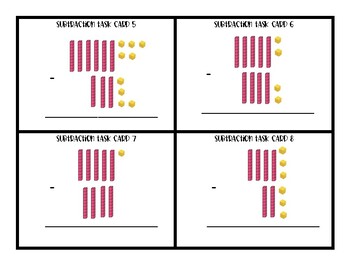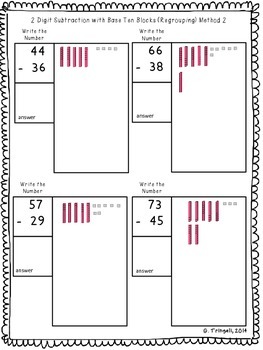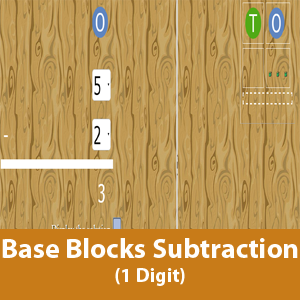

#Base ten blocks subtraction series#
Three classes of second graders (N=75) completed the initial subtraction learning and demonstrated meaningful subtraction concepts. 55 results: base ten blocks subtraction Clear All Sort By: Relevance + Printables K-5 Math Teaching Resources Base Ten Cards (tens and ones) For Students K - 2nd Standards Strengthen your classs understanding of place value with this series of base-ten flash cards. In Study 1 six of the eight classes of first and second graders (N=169) demonstrated meaningful multidigit addition and place-value concepts up to at least four-digit numbers average-achieving first graders showed more limited understanding.

If you want to be a teacher that just teaches kids the steps and lets them copy you, then fine.

You can pretty much count on your typical first grader, taking away the whole ten rod instead of trying to exchange it for ones and only take away part of it. Children practiced multidigit problems of from five to eight places after they could successfully add or subtract smaller problems without using the blocks. And if they need to break apart the ten to subtract Forget about it. Steps in addition and subtraction of four-digit numbers were motivated by the size of the blocks and then were carried out with the blocks each step was immediately recorded with base-ten numerals. Circle 21 A puzzle involving adding positive and negative integers to sum to twenty one. Circle 0 A puzzle involving adding positive and negative integers to sum to zero.

Chip Abacus Learn about carrying and digits using chips. We could add to the number of students who got on the bus until we get to the total.A learning/teaching approach used base-ten blocks to embody the English named-value system of number words and digit cards to embody the positional base-ten system of numeration. Base Blocks Subtraction Use base ten blocks to model separation of groups in subtraction. “What are different ways we can solve this problem?” (We could subtract the number of students who got on the bus second from the total.Subtracting with base ten blocks: Subtracting with quick pictures. Do your students need help visualizing when subtracting 3-digit numbers without regrouping using base ten blocks Your students will get that practice when. 3rd Read: Read the entire problem, including the question aloud. Using varied strategies, based on place value, to visualize subtraction.“What are all the things we can count in this story?” (number of students who started the story on the bus, number of students who got on next, the total number of students on the bus, the number of buses).2nd Read: “Some students were on the bus to go to the zoo.Listen for and clarify any questions about the context. To subtract using base-10 blocks, your child will use place value blocks as a tool to subtract 1-digit numbers from 2-digit numbers.1st Read: “Some students were on the bus to go to the zoo.“We are going to read this problem 3 times.” To subtract using base-10 blocks, your child will use place value blocks as a tool to subtract 1-digit numbers from 2-digit numbers.Display only the story problem, without revealing the question. Results for subtracting tens with base ten blocks 970 + results Sort by: Relevance View: List Double Digit Subtraction without Regrouping Worksheets with Base Ten Blocks Created by Danas Wonderland This product contains worksheets that focus on double-digit subtraction without regrouping.“Did everyone on your field trip stay together the whole time or did you split into smaller groups?” Math Grade 1 Base 10 blocks Addition Adding with base 10 blocks 2-digit numbers & base 10 blocks In these math worksheets, students solve addition problems by drawing and combining rods ('tens') and blocks ('ones').You may also select which numbers that will be used in the problems. They can be used to show place value for numbers and to increase understanding of addition and subtraction algorithms. The Base Ten Blocks Worksheets gives you the option to select different combinations of the ones, tens, hundreds, and thousands blocks to produce different problems. “Have you ever been on a field trip? Where did you go?” Base blocks consist of individual 'units,' 'longs,' 'flats,' and 'blocks' (ten of each set for base 10).Give students access to connecting cubes and base-ten blocks.


 0 kommentar(er)
0 kommentar(er)
